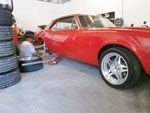
Today, everybody's got custom wheels. The guy driving the Escalade to work runs 24s with paper-thin sidewalls and those ridiculous spinner wheels. Even the pizza-delivery kid's got 18s on his Honda. You also see these same poseurs stranded along the freeway or stuck in a parking lot with a squared-off wheel or sliced sidewall for their efforts. So how do you make your mark on the boulevard big spin?
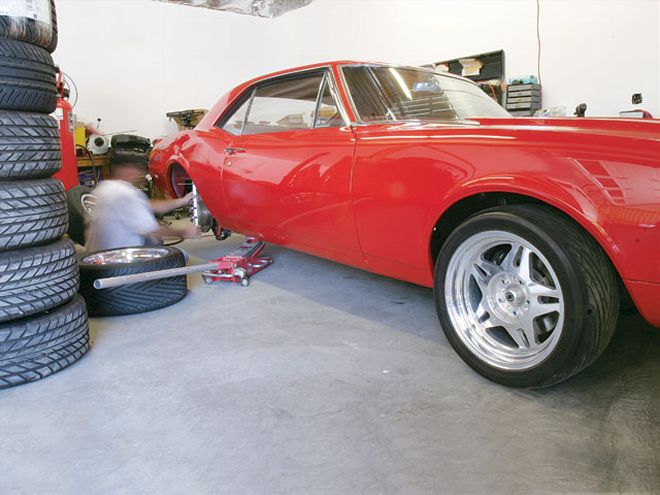 Careful measurement and double-checking your work will be rewarded with a good-looking wheel-and-tire package that doesn't gouge your tires or your wallet.
Careful measurement and double-checking your work will be rewarded with a good-looking wheel-and-tire package that doesn't gouge your tires or your wallet.
Just like camshafts and the super-size-me option at your local burger stand, everybody defaults to "bigger is badder," and nothing abuses that statement more than fat tires and wheels. We'll look at both the cool, corner-turning stuff and drag-race meats with this story, where the goal is to stuff big tires under the wheelwells. This is a challenge but rewarding as hell when it works. The key here is to do your research first, then buy. Too many mistakes are made when the urge to spend the big bucks on a set of fat tires and wheels is just too great before you really know what will fit. We'll look at those short-sidewall hero tires and tell you how to fit big, sticky rear tires under your supercar. Just remember, once those tires are mounted on the wheels, you can't take 'em back.
Gimme My Backspace
While big, fat tires may be the ultimate point of this exercise, we need to start with wheels. Most car crafters are familiar with wheel diameter and width. These two dimensions are easy to measure. But in the art of stuffing fat tires, it's the backspace that makes all the difference. It's just not cool to jack up a car to fit fat rollers. That's a disaster for so many reasons we shouldn't have to warn you about them. The aggressive, mean-spirited corner burner is all about a low stance and big meats on all four corners. The simple solution is to stuff the wheel-and-tire package as far inboard as possible while clearing everything that conspires to get in your way.
The way to do this is with wheel backspacing. This is the measurement between the wheel mounting flange and the inner wheel lip. Some manufacturers still refer to backspacing as offset, but this is confusing. It's much simpler to merely refer to the amount of backspacing. For example, let's say we have a 17x8-inch wheel with 4 inches of backspacing. This places the mounting flange in the middle of the wheel width. Today's wheel manufacturers have figured out that even the older musclecars offer room to fit wider tires and wheels if the wheels come with more backspacing. Today, it's not unusual to see a 17x8-inch wheel with 5 to as much as 7 inches of backspacing. As backspacing distance increases, the mounting flange moves closer to the outside edge of the wheel. This is called a positive offset. For example, all C4 and later Corvette wheels are built this way.
The inside diameter of the wheel is also important if your car is equipped with larger-than-stock disc brakes. Most brake companies are less than specific about minimum wheel diameter clearance, mainly because each wheel company's drop dimension for a given diameter varies with the style of the wheel. This means you can't assume, for example, that all 16-inch wheels will clear a set of Wilwood 13-inch rotor brakes. The only way to know for sure is to mount a wheel on your hub and measure the caliper clearance.
Section Smarts
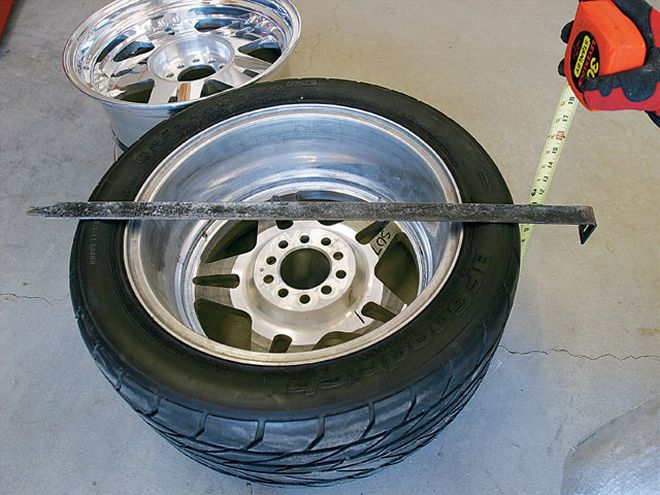 The only way to know exactly the section-width dimension is to measure it with the tire mounted on the wheel as shown. Tire manufacturers publish section-width information based on a given wheel width.
The only way to know exactly the section-width dimension is to measure it with the tire mounted on the wheel as shown. Tire manufacturers publish section-width information based on a given wheel width.
When someone asks, "How wide is that tire?" the universal answer is always with regard to tread width. But the savvy tire stuffer knows section width is the real key to measuring tire width. Section width is the distance across the tire at its widest portion of the sidewall with the tire mounted on a given-width wheel. The section width will change slightly depending on the width of the wheel. The tire companies publish dimensions of each size tire based on a given wheel width.
For example, a BFGoodrich 275/40ZR17 g-Force T/A KD tire has a section width of 10.9 inches when mounted on a 9.5-inch-wide wheel. BFG also states that for every 1/2 inch of wheel-width change, the section width will vary by roughly 0.2 inch. So if we were to mount that same tire on a 9-inch wheel, the section width would be reduced to 10.7 inches. There is also an ideal wheel-width range for any size tire. BFG recommends that this size tire be used on wheels ranging from 9.0 to 11.0 inches. On an 11-inch wheel, the section width would be a wider 11.5 inches.
Don't assume that all same-size tires have identical section widths. Tire diameter is closely maintained, but section width has a tendency to vary between manufacturers. We have measured the section width of the same size BFG, Firestone, and Goodyear tires mounted on exactly the same wheel and discovered major differences in section width. This means you can't assume that just because your buddy's BFG tires fit cleanly that your Goodyears will generate the same clearance.
Measure Twice, Fit Once
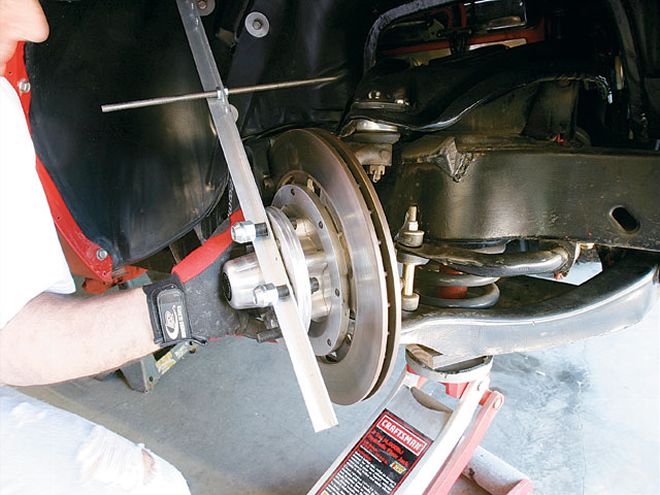 This simple, homemade tool works best on the rear and can be used to simulate either the wheel width or the section width of the tire to establish proper clearance. The tool can be used on the front, but it's more difficult to ensure that everything will clear. The problem is simulating ride height while being able to turn the wheel to check for clearance. Try placing the floor jack directly underneath the lower ball joint and raising the jack to ride height. This is especially important because the front suspension moves in an arc inboard as it moves up into the wheelwell.
This simple, homemade tool works best on the rear and can be used to simulate either the wheel width or the section width of the tire to establish proper clearance. The tool can be used on the front, but it's more difficult to ensure that everything will clear. The problem is simulating ride height while being able to turn the wheel to check for clearance. Try placing the floor jack directly underneath the lower ball joint and raising the jack to ride height. This is especially important because the front suspension moves in an arc inboard as it moves up into the wheelwell.
In the performance world, the idea is to stuff as much tire and wheel under the wheelwells as possible. Many car crafters make the mistake of getting all amped up over buying a trick set of wheels and tires only to discover the big meats don't fit. A better plan is to measure twice or even three times and then go with what you know will fit. The easiest and ideal way to measure is to just bolt on a set of wheels and tires from a buddy's car to see if they will fit your car. That's not always the most convenient idea, but it's ultimately the best.
If you are going to measure your clearance area, there are several variables that come into play that affect tire clearance. The most important one is ride height. The worst thing to do is to measure the car for tire clearance, purchase the tires and wheels, and then decide to lower the car. If you are considering dropping the stance, do it before you purchase the tires and wheels. A lower ride height will affect especially the front tire clearance and may be the difference in one whole tire-size change. For example, at factory ride height, an early Camaro might be able to accommodate a 255/50R16 tire on a 16x8-inch wheel, but lower it by 1 inch, and that size might drop to a 245/50R15 tire. The inner wheelwell clearance is the issue; it becomes much tighter with a lower ride height.
To fit the widest tire-and-wheel package, the car will need the maximum wheel backspacing on the frontend. Stock upper control arms may contact the wheel, or sometimes (depending on wheel diameter) the tie-rod end will limit the amount of backspacing. The next thing that will often hit on full-lock turns is the sway bar. A minor amount of sidewall rub at full lock could be acceptable since the only time this would occur is in parking situations.
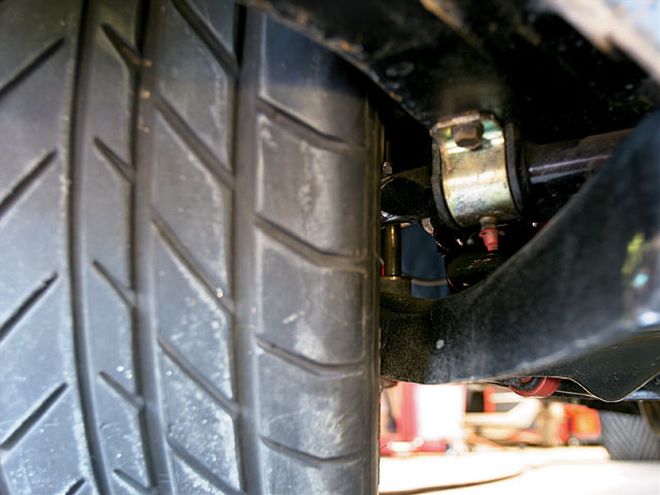 Here, this front tire-and-wheel package is too far inboard, contacting the sway bar long before the steering hits the stops. Always check clearance at ride height with the steering at full lock.
Here, this front tire-and-wheel package is too far inboard, contacting the sway bar long before the steering hits the stops. Always check clearance at ride height with the steering at full lock.
We've built a homemade wheel backspacing and sidewall section-width checker out of a piece of aluminum and a length of all-thread. We drilled two holes to mount the gauge to the brake hub and then drilled a series of holes from the axle centerline out to simulate the radius of a 15-, 16-, and 17-inch wheel. Then we drilled three more holes to simulate the radius of tire diameters of 26, 27, and 28 inches. The length of all-thread is placed through either a wheel or tire hole (or both with two lengths of all-thread) and then inside or outside dimensions can be checked.
We also found a professional tire-and-wheel fitment tool that is far more sophisticated and will quickly determine wheel diameter, width, backspacing, and tire profile. This tool is more expensive than our homemade gizmo, but perhaps you can find a shop that has one of these tools to help you find your data much more quickly. Percy's offers a tool called the WheelRite simulator for $89.99 through its Web site.
Fat Back Fitness
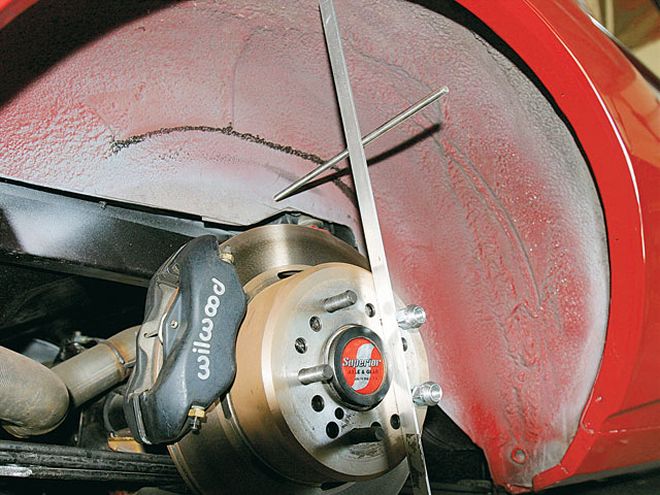 Measuring rear wheel room is a little easier than measuring the front. Remember that most outer wheelwells tend to move inboard as they taper toward the front of the car.
Measuring rear wheel room is a little easier than measuring the front. Remember that most outer wheelwells tend to move inboard as they taper toward the front of the car.
Stuffing fat tires with short, stiff sidewalls under the rearend is a little easier. One big reason is that the sidewalls on these 16-, 17-, and 18-inch tires tend to stay put, unlike tall, two-ply wrinkle-wall drag tires that move around a bunch. We'll deal with both styles here. Always measure both sides of the car when determining maximum tire size. Often, the body does not sit squarely on the chassis, reducing outer wheelwell clearance on one side and inner wheelwell clearance on the opposite side. This is extremely common with older musclecars. If the car is more than 1/2 to 3/4 inch offset, consider loosening all the body-mount bolts (on a full-frame car) and shifting the body to make it more square over the chassis. Our experience with GM cars is that the rear axle tends to be offset to the passenger side. This creates a tight clearance on the outboard of the passenger side and inboard on the driver side. On earlier unibody cars like Camaros, Novas, Mustangs, and Challenger/'Cudas, you may have to live with the offset unless there are minitubs in the car's future.
When measuring rear tire clearance, minimizing body roll will allow you to run a larger rear tire with tighter clearance. The biggest hurdle is most rear axles tend to articulate, which occurs when you enter a steep driveway at an angle and one tire angles into the rear wheelwell more than the other. This generally demands more clearance if this is a problem.
Tire-clearance limitations are often traced to the leaf spring, which intrudes into the wheelwell area. Several companies offer offset-shackle kits for specific cars. For early Camaros and '68-'74 Novas, Detroit Speed offers an offset-shackle kit (PN 040901 for $275) that uses billet aluminum pieces to move the springs to accommodate up to a 335/ 40R17 or 18-inch tire with a 13.5-inch section width. This kit works in conjunction with minitubs that add additional clearance. Mopar Performance sells kits for A-Bodies (PN 4876558AB, $119.95 from summitracing.com) and B/E-Bodies (PN 4120665AB, $99.95 from summitracing.com). These conversions require some fabrication work to optimize tire clearance, so they cannot be considered a basic bolt-on.
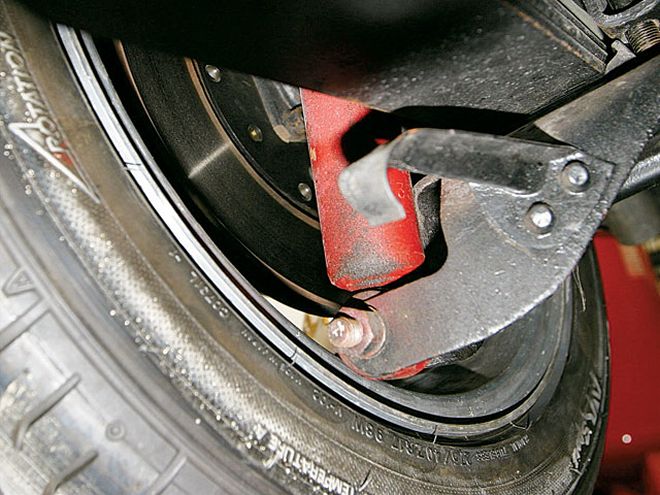 In this early Camaro application, the lower shock absorber is the limiting factor to moving the wheel more inboard. We adjusted the mount to create enough clearance, which is pretty tight. The best fix is to cut the shock mount and move it inboard.
In this early Camaro application, the lower shock absorber is the limiting factor to moving the wheel more inboard. We adjusted the mount to create enough clearance, which is pretty tight. The best fix is to cut the shock mount and move it inboard.
Fitting fat, rear drag tires involves a little more work because you must be concerned with taller-sidewall tires and much more lateral sidewall movement. This will require much more clearance than short-sidewall tires. With DOT-legal drag tires, you need to be careful when researching rear tire dimensions. The best process is to actually mount a friend's tire-and-wheel combination before you buy. If not, then using our tire-and-wheel tool can be helpful. Remember to always check the clearances at ride height, not with the car sitting on jackstands under the frame and the suspension in full extension.
If you decide to trim the inner fender lip to improve tire clearance, it can be worth as much as 3/4 inch. But move carefully here; if you need to remove most of the lip area for clearance, carefully trim it back rather than rolling the lip under. The difference between rolling and cutting is an additional 1/8 to 1/4 inch. Don't cut all the way out to the edge because many cars use a pinch weld to hold the inner fenderwell and outer fender together. If you cut through this, you'll have to carefully weld them back together. If the car is already painted, this will cause problems. Ask us how we know. END